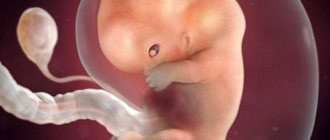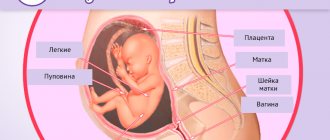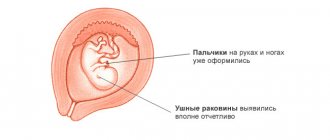What changes occur in the female body at 42 weeks of gestation
During the last week of pregnancy, the mother's body is actively preparing for the upcoming birth. The pelvic bones gradually diverge, so that a fairly large fetal head can pass through the birth canal. In this case, the expectant mother may experience pain in the lower abdomen and lower back. The cervix is also preparing for the upcoming birth process: it becomes softer, shorter and can begin to open at any time. Labor is controlled by the hormones vasopressin and oxytocin, the levels of which begin to increase on the eve of childbirth.
If at 42 weeks of pregnancy the baby has not yet been born, there is no need to worry. Pregnancy is considered post-term from 43 weeks. Most likely, an error was made when calculating the estimated due date.
Many expectant mothers are interested in the question of why the 42nd week of pregnancy has arrived, but labor does not begin and there are no contractions? There may be several reasons for this:
- Incorrect calculation of the expected date of labor. The correct date of delivery is determined only in 5% of cases. This is due to the fact that only some women can indicate the exact date of fertilization;
- Factors that influence gestational age. The duration of gestation depends on the length of the menstrual cycle, the day of ovulation, the presence of possible endocrine disorders, the woman’s age and genetic factors. For expectant mothers with a menstrual cycle longer than 28 days, pregnancy over 40 weeks is not considered post-term. Women whose menstrual cycle lasts less than 28 days give birth before the due date;
- Complications of pregnancy in the first trimester of gestation. The presence of various abnormalities and disorders in the early stages of pregnancy increases the likelihood of post-term pregnancy.
Weight gain
There are no significant changes in this issue compared to other weeks. The woman no longer recovers; on the contrary, she may lose 1–2 kg (this is due to the loss of fluid by the tissues on the eve of childbirth).
Due to the large belly at 42 weeks, the mother is constrained in her movements and cannot completely relax. Or maybe psycho-emotional stress is the reason that the child has not yet been born? Talk, as psychologists advise, to your “tummy” and ask your baby to “speed up.”
What happens to the baby at 42 weeks of pregnancy
At this stage, the fetus continues to grow and increase body weight. Now his weight is from 3.5 to 4 kg, and his height is 52-57 cm. The child is already quite large, so the only difficulty that may arise against the background of his prolonged stay in the mother’s womb is the slow and more difficult passage of the baby through the birth canal. The skull bones become harder. This can lead to a protracted labor, long contractions, and birth injuries to the newborn.
It should be taken into account that post-term pregnancy can affect the health of the baby. After 42 weeks, the placenta becomes old, which leads to disruption of the supply of oxygen and nutrients to the baby. This can cause fetal hypoxia and disruption of brain activity.
When the baby does not have enough oxygen, he involuntarily begins to excrete feces into the amniotic fluid. The entry of meconium along with amniotic fluid into his body can lead to the fact that after birth the child will not be able to breathe on his own. In such a situation, the baby is prescribed antibacterial drugs and ventilated.
What does the baby look like at 42 weeks: assessing his condition during prolonged pregnancy
At this stage, the baby is completely ready for independent life. His weight in many cases exceeds three and a half kilograms, and his height is fifty centimeters. At the same time, he still continues to grow in the tummy, and this is a danger for him and his mother. After all, a large baby has a much harder time passing through the birth canal.
By the forty-second week, the baby already has enough fat layer, you can see a fluff of hair on the head, and some babies can even boast of thick hair. All the baby’s internal organs function perfectly, and he is well prepared to exist separately from his mother. Therefore, you can calmly wait until he finally decides to appear in this world.
However, at this stage the baby does not always feel as comfortable as we described. In cases where doctors determine postmaturity, everything does not look so rosy.
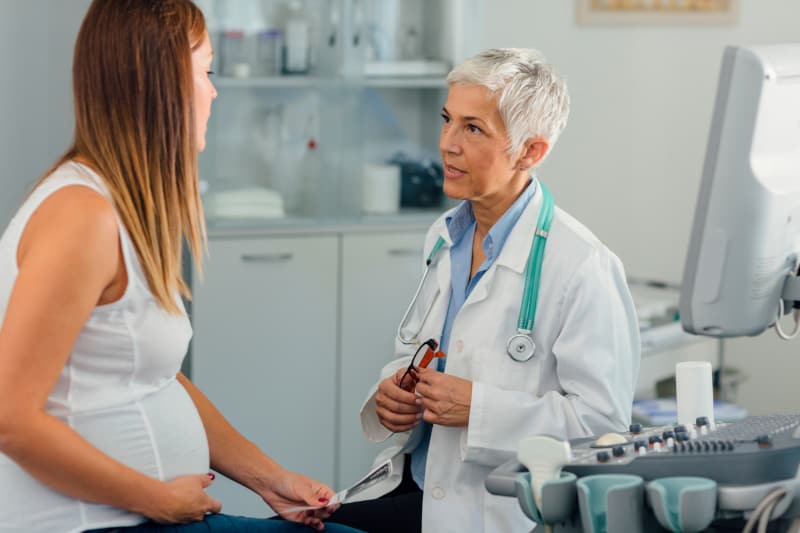
Feelings of the expectant mother at 42 weeks of gestation
Most women at this stage begin to fall into a depressive state. Anticipation of childbirth, worries and fatigue lead to apathy and psycho-emotional disorders.
Also, the expectant mother may encounter a number of unpleasant sensations:
- Stool disorder (constipation, diarrhea). Such disorders are caused by hormonal changes and pressure from the enlarged uterus on the organs of the digestive system;
- Edema. At this stage, more than 70% of pregnant women suffer from swelling. With normal blood pressure and the absence of protein in the urine, this condition is not dangerous;
- Development of hemorrhoids. It usually occurs due to pressure from the uterus on the perineum and intestines.
If the pregnancy is progressing normally, the expectant mother can stay at home until regular contractions occur. If amniotic fluid breaks, you should go to the maternity hospital without waiting for contractions to appear. If a mucus plug falls out, there is no need to rush to the maternity hospital. As a rule, it leaves a few days before the onset of the birth process.
Also, the expectant mother needs to remember about the dangerous symptoms of the 42nd week of pregnancy, which should immediately contact a doctor if they occur:
- Bloody discharge from the genital tract;
- Continuous tone of the uterus, accompanied by severe pain in the lower abdomen;
- Frequent attacks of headaches, increased blood pressure, blurred vision, nausea, vomiting;
- Complete absence or excessively active fetal movements.
When to go to the maternity hospital
Childbirth at 42 weeks of pregnancy is just around the corner and contractions can begin at any time of the day or night. For multiparous mothers, the whole process sometimes happens so quickly that there is very little time left to think.
You might be interested in: Is it possible to have a tooth removed during pregnancy?
So, when you need to urgently go to the hospital:
- water broke;
- regular contractions began;
- bloody discharge appeared from the vagina;
- blood pressure has increased or, conversely, decreased;
- signs of late toxicosis appeared - swelling, vomiting, nausea, fainting;
- there was severe pain in the lower abdomen;
- body temperature increased.
At week 42, doctors often recommend that mommy go to the hospital. During this period, the woman and child face a variety of dangers, and it is better if the pregnant woman is under the supervision of doctors at this time.
Medical examination at 42 weeks of gestation
During this period, the expectant mother must visit a doctor and have her urine tested. To monitor the condition of the fetus and mother, the following studies may be prescribed:
- CTG (cardiotocography). It is carried out to assess the baby’s cardiac activity;
- Ultrasound scanning. Allows you to determine the location and degree of development of the fetus, as well as visualize the condition of the uterine cervix. During ultrasound diagnostics, the doctor can detect pathological abnormalities that require stimulation of labor;
- Amnioscopy. Prescribed to determine the condition of amniotic fluid and placenta.
If the above studies do not reveal any abnormalities, the doctor will recommend waiting until natural delivery occurs. If dangerous conditions and pathologies are detected at 42 weeks of pregnancy, the obstetrician-gynecologist decides on the advisability of inducing labor or cesarean section.
Need for medical supervision
At 42 weeks, a woman should visit her doctor regularly. Usually, during a prolonged pregnancy, the mother is prescribed additional examination methods, which is necessary to monitor the condition of the baby and the girl herself.
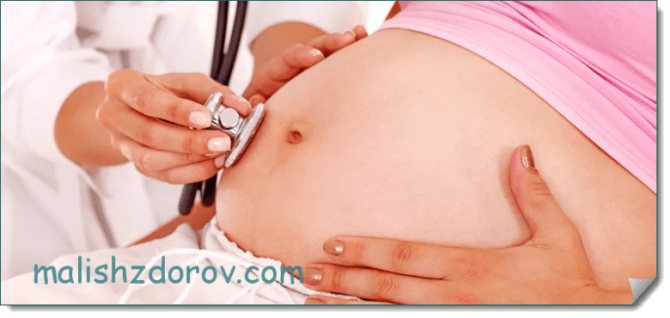
The following criteria are assessed:
- The condition of the cervix, its length and degree of softening.
- Baby's heartbeat.
- Quantity and quality of amniotic fluid.
- Condition of the placenta, degree of its aging.
- Number of fetal movements.
You might be interested in: Pulling in the lower abdomen during early pregnancy without discharge
Ultrasound examination and cardiotocography are mandatory. In addition, the results of the so-called trigeminal analysis for hCG, estriol and AFP are taken into account, which reveals various developmental pathologies in the fetus.
Read more about hCG levels at different stages of pregnancy here.
Possible pregnancy problems at 42 weeks
The risk of developing eclampsia (late gestosis) and placental abruption remains at this stage. In some cases, the labor process does not begin due to a deficiency of the hormones that regulate it (vasopressin and oxytocin). In such a case, the woman may be prescribed corrective hormonal therapy.
If there is a suspicion of post-term pregnancy, the expectant mother is offered to induce labor.
Stimulation of labor in a maternity hospital
In the maternity hospital, labor is induced using oxytocin. This is a drug that, together with prostaglandin (a female hormone), causes contraction of the uterine muscles. If after this contractions do not appear at 42 weeks of pregnancy, and the cervix begins to dilate, the bladder is punctured.
Induction of labor can also be done at home. The best method for accelerating labor is considered to be unprotected sexual intercourse. Male sperm contains prostaglandins, and during stimulation of the nipples the hormone oxytocin is produced, which together can cause uterine contractions. In addition, during arousal in the pelvic organs, blood circulation increases, which can provoke the onset of contractions and an increase in the tone of the uterus.
You can also stimulate labor at home by performing useful physical activities (dancing, climbing stairs). You can try to stick to a diet rich in vegetable oil and vegetables. Increased intestinal peristalsis can cause uterine contractions and the onset of contractions. In order not to complicate the birth process and not harm the baby, the listed methods of inducing labor should be used extremely carefully and only after consultation with a doctor.
Recommendations
At the 41st - 42nd week of pregnancy, you need to take a break from waiting for the onset of labor and lead a normal lifestyle. Be more active: walk in the fresh air, walk up the stairs, do swimming, gymnastics and do not give up your intimate life. During this period, it is important to continue to monitor changes in your weight, because not only extra pounds, but also lack of body weight negatively affects the child.
If at 41–42 weeks of pregnancy you experience digestive problems (constipation, diarrhea, dysbacteriosis), a healthy diet and daily routine will help. Eat often, but in small portions, eat more foods rich in plant fiber. These are cereals, vegetables, fruits, wholemeal bread. And fermented milk products contain probiotics, protein and calcium, so you should definitely have cottage cheese, kefir, yogurt and natural yoghurt on your table.
The moment when you will see your long-awaited baby is just around the corner. And to speed up its birth, you can use safe methods of self-stimulation of labor at 42 weeks of pregnancy:
- Nipple massage. If you do it three times a day for 15 minutes, the level of oxytocin in the blood, a hormone that stimulates labor, will significantly increase;
- Sexual intercourse. Orgasm promotes contraction of the uterine muscles, and sperm contains prostaglandins, which help soften the cervix and contract its muscles. Therefore, intimacy at 41–42 weeks of pregnancy is not only allowed, but recommended by doctors.
Prohibitions and recommendations at 42 weeks of pregnancy
During this period, it is important to maintain composure and calm. In the last weeks of pregnancy, this is quite difficult to do, but in some cases it is emotional imbalance that provokes inhibition of labor. Walking in the open air, watching your favorite movies, reading books or calm music can help you relax.
Nutritional Features
Many pregnant women experience decreased appetite this week. Childbirth is a difficult process that requires a lot of energy and strength from a woman, so you need to try to eat something. This could be a piece of chocolate, yoghurt, fruit or cake. The main thing is not to starve and eat a little every 2-3 hours. If possible, the diet should include meat and fish dishes, dairy products and a variety of cereals.
Taking vitamins
Vitamins that were prescribed by a doctor during pregnancy (calcium, vitamin D, multivitamin complexes) can be taken after childbirth. If necessary, they are replaced with drugs for nursing.
Sex at 42 weeks pregnant
As a rule, most expectant mothers have a significantly reduced sex drive this week, due to fatigue and anxiety. Intimate relationships are a safe and natural way to stimulate the birth process. Sexual contacts this week are allowed for women whose pregnancy proceeds without deviations or pathologies. After the mucus plug has passed, the risk of infection of the membranes increases significantly, so it is better to use a condom or carefully monitor the hygiene of your intimate areas.
Physical activity
Moderate physical activity is beneficial at any stage of pregnancy. In recent weeks, most exercises become unbearable for a woman. Walking in the open air will help keep your body in good shape. You can also do breathing exercises and Kegel exercises. Trying to stimulate labor through physical activity is not recommended. This may affect the delivery process.
Medical procedures, taking medications
During this period, any medical manipulations should be carried out under the supervision of a specialist. Taking any medications without a doctor's prescription is not recommended. If complaints and pathological symptoms arise, it is better to consult a doctor who, taking into account the potential benefits for the mother and possible harm to the fetus, will select the safest medicine.
If there are no signs of labor before the end of the 42nd week of pregnancy, you should contact an obstetrician-gynecologist. The doctor will conduct the necessary examinations, assess the health of the fetus and the expectant mother, and also develop tactics for further action.
Fetal development at 42 weeks of gestation
Exactly forty weeks have passed since conception, when the egg released from the ovary after ovulation was fertilized by sperm and attached to the wall of the uterus in order to further grow, develop and, at the end of its journey, turn into a full-fledged little person. It was from the moment of implantation of the blastocyst that the process of embryonic development of the future baby began.
Now the last, forty-second week of gestation is ending, but the baby continues to gain weight and grow. At this stage, the baby weighs 3600 grams, and his height is from 55 to 57 centimeters. Based on these data, gynecologists conclude that pregnancy is coming to its logical conclusion. If labor does not begin at this stage, this will lead to serious consequences for both the mother and the baby; it is for this reason that if labor is absent at the end of the week, then gynecologists artificially stimulate it or perform a cesarean section.
What's happening to the baby
The baby's head has already taken a clear position between the pelvic bones, through which it will need to pass when it is born. She is now pressed tightly against them. At the moment, the adrenal glands begin to actively work in the baby’s body, producing secretory elements that will help the baby more easily endure the stress of being born.
At this time, the child may begin to harden the bone joints of the skull, which must remain flexible until birth to help the baby pass through the birth canal without injury or complications. If they harden, the woman is referred for a caesarean section.
When performing an ultrasound examination at this stage, the doctor may notice that the child does not feel very well. He will have dry and wrinkled skin due to lack of vernix, excessively long nail plates on the fingers and toes, as well as increased motor activity as a result of lack of oxygen.
If the baby has not received enough oxygen and nutrients for a long time, then he may develop abnormalities. But such problems arise extremely rarely, mainly in the forty-second week; babies are born healthy and are no different from those babies who were born earlier.
If you are planning to have another baby, you can read the information from the very first week of pregnancy, in which you will find how the fetus develops, recommendations from a gynecologist and much more. All the necessary information is in this article.

What does the belly look like at 42 weeks pregnant?
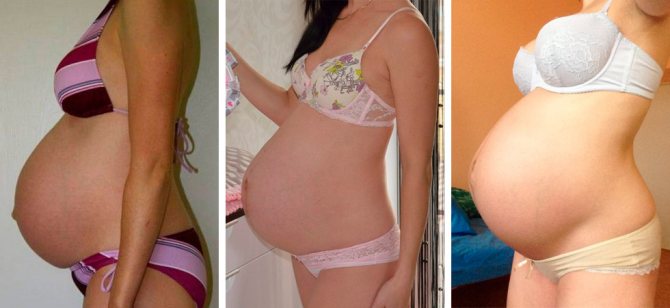
Attention!
This article is posted for informational purposes only and under no circumstances constitutes scientific material or medical advice and should not serve as a substitute for an in-person consultation with a professional physician.
For diagnostics, diagnosis and treatment, contact qualified doctors! Number of reads: 1573 Date of publication: November 28, 2017
Gynecologists - search service and appointment with gynecologists in Moscow
Sex at 42 weeks of pregnancy
Gynecologists recommend sex in the forty-second week of gestation in order to speed up labor. However, intimacy should be careful without pressure on the stomach and unpleasant sensations on the part of the expectant mother.
It is better to have sex without a condom, since sperm allows you to soften the cervix and facilitate the release of the mucous plug from it, and accordingly provoke labor.

